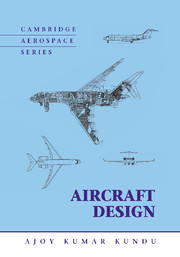Book contents
- Frontmatter
- Contents
- List of Symbols and Abbreviations
- Preface
- Road Map of the Book
- 1 Introduction
- 2 Methodology to Aircraft Design, Market Survey, and Airworthiness
- 3 Aerodynamic Considerations
- 4 Aircraft Classification, Statistics, and Choices for Configuration
- 5 Aircraft Load
- 6 Configuring Aircraft
- 7 Undercarriage
- 8 Aircraft Weight and Center of Gravity Estimation
- 9 Aircraft Drag
- 10 Aircraft Power Plant and Integration
- 11 Aircraft Sizing, Engine Matching, and Variant Derivative
- 12 Stability Considerations Affecting Aircraft Configuration
- 13 Aircraft Performance
- 14 Computational Fluid Dynamics
- 15 Miscellaneous Design Considerations
- 16 Aircraft Cost Considerations
- 17 Aircraft Manufacturing Considerations
- Appendix A Conversion
- Appendix B International Standard Atmosphere
- Appendix C Aerofoils
- Appendix D Case Studies
- Appendix E Tire Data
- References
- Index
1 - Introduction
Published online by Cambridge University Press: 05 June 2012
- Frontmatter
- Contents
- List of Symbols and Abbreviations
- Preface
- Road Map of the Book
- 1 Introduction
- 2 Methodology to Aircraft Design, Market Survey, and Airworthiness
- 3 Aerodynamic Considerations
- 4 Aircraft Classification, Statistics, and Choices for Configuration
- 5 Aircraft Load
- 6 Configuring Aircraft
- 7 Undercarriage
- 8 Aircraft Weight and Center of Gravity Estimation
- 9 Aircraft Drag
- 10 Aircraft Power Plant and Integration
- 11 Aircraft Sizing, Engine Matching, and Variant Derivative
- 12 Stability Considerations Affecting Aircraft Configuration
- 13 Aircraft Performance
- 14 Computational Fluid Dynamics
- 15 Miscellaneous Design Considerations
- 16 Aircraft Cost Considerations
- 17 Aircraft Manufacturing Considerations
- Appendix A Conversion
- Appendix B International Standard Atmosphere
- Appendix C Aerofoils
- Appendix D Case Studies
- Appendix E Tire Data
- References
- Index
Summary
Overview
This book begins with a brief historical introduction in which our aeronautical legacy is surveyed. The historical background illustrates the human quest to conquer the sky and is manifested in a system shaping society as it stands today: in commerce, travel, and defense. Its academic outcome is to prepare the next generation for the advancement of this cause.
Some of the discussion in this chapter is based on personal experience and is shared by many of my colleagues in several countries; I do not contest any differences of opinion. Aerospace is not only multidisciplinary but also multidimensional – it may look different from varying points of view. Only this chapter is written in the first person to retain personal comments as well as for easy reading.
Current trends indicate maturing technology of the classical aeronautical sciences with diminishing returns on investment, making the industry cost-conscious. To sustain the industry, newer avenues are being searched through better manufacturing philosophies. Future trends indicate “globalization,” with multinational efforts to advance technology to be better, faster, and less expensive beyond existing limits.
What Is to Be Learned?
This chapter covers the following topics:
Section 1.2: A brief historical background
Section 1.3: Current design trends for civil and military aircraft
Section 1.4: Future design trends for civil and military aircraft
Section 1.5: The classroom learning process
Section 1.6: Units and dimensions
Section 1.7: The importance of cost for aircraft designers
Coursework Content
There is no classroom work in this chapter, but I recommend reading it to motivate readers to learn about our inheritance.
- Type
- Chapter
- Information
- Aircraft Design , pp. 1 - 18Publisher: Cambridge University PressPrint publication year: 2010

